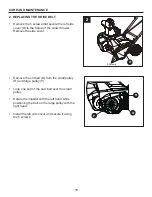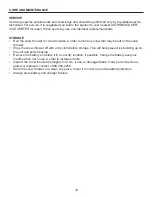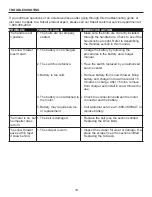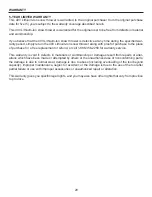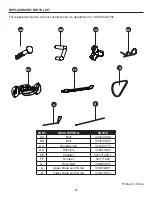
14
OPERATING INSTRUCTIONS
OPERATING TIPS
WARNING
If the snow thrower hits a foreign object while it is in use, the object could be thrown in the direction of
the operator or a bystander. Thrown objects could cause serious personal injury. Keep the area to be
cleared free of all foreign objects that may be picked up and thrown by the impeller.
• Keep the area of operation free of foreign objects that can become thrown by the impeller. Per-
form a thorough inspection of the area since some objects may be hidden from view by surround-
ing snow. lf the snow thrower hits an obstruction or picks up a foreign object during use, stop the
snow thrower, remove the battery, remove the obstruction, and inspect the unit for damage. Repair
or replace any damaged part before restarting and operating the unit.
• Keep children, pets, and bystanders away from the area of operation. Be aware that the normal
noise of the machine when turned on may make it difficult for you to hear approaching people.
• When moving the snow thrower, use the wheels on one side as the pivot point. Slightly tilt the
snow thrower on this pivot point to move it forward or backward.
• Start your clearing path outward, throwing snow in a back and forth motion. To clear in the oppo-
site direction, pivot the snow thrower on its wheels. Make sure to overlap clearing paths.
• Note the wind direction. If possible, move in the same direction as the wind so that the snow is not
thrown against the wind (and thus back onto you and on the just cleared path).
• Do not push the snow thrower with excessive force. You should push the machine gently and at a
consistent speed in accordance with the unit's throw rate.
• Some parts of the snow thrower may freeze under extreme temperature conditions. Do not at-
tempt to operate the snow thrower with frozen parts. If the parts freeze while the snow thrower
is in use, stop the snow thrower, remove the battery, and inspect for frozen parts. Free all parts
before restarting or operating the snow thrower. Never force controls that are frozen.
• When working on pebbles, gravel, or unpaved surfaces, avoid throwing loose surface material
along with the snow by pushing down on the handle to raise the scraper at the base of the unit
above the pebbles or gravel.
• Cold Weather Operation: Lithium-Ion batteries can be safely used from temperatures ranging from
39°F (4°C) to 104°F (40°C).
NOTE
: Do not store or charge battery outside. Battery must be charged and stored indoors prior
to use of the snow thrower.
• If the snow thrower does not start, initially remove battery from snow thrower. Place battery on
charger and allow to charge for 10 minutes. Remove from charger and install in snow thrower for
use. The start-up issue may be caused from the battery being too cold. To avoid this issue, ensure
battery is stored in a dry cool place for storage and charging and leave indoors until ready for use.

















